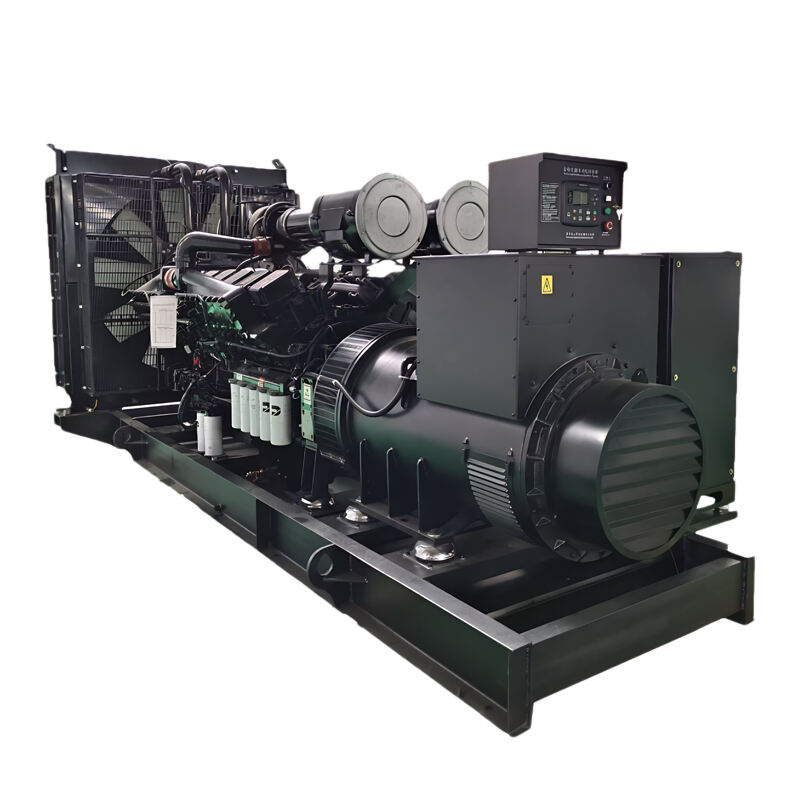Elektr energiya ishlab chiqarish texnologiyasidagi so'nggi yutuqlar nimalardan iborat?
Global energiya doirasida doim o'zgaruvchanlikka qaramasdan, elektr energiya yaratish texnologiya o'zgarishning yetakchi qismi hisoblanadi. O'sayotgan energiya ehtiyojlarini qondirish va uglerod chiqindilarini kamaytirish vazifalarini hal etish uchun oxirgi yutuqlar turli energetik manbalarda - fosil yoqilg'ulardan yangilanuvchi va yadroviy energiyagacha bo'lgan sohalarni qamrab olmoqda. Bu innovatsiyalar faqatgina samaradorlikni oshirish bilan birga elektr energiya yaratish ham barqaror energetika kelajigiga yo'l ochmoqda.
Fosil yoqilg'i bilan elektr energiyasi ishlab chiqarishdagi yutuqlar
Ultra-yuqori kritik va ilg'or CFB texnologiyalari
Qayta tiklanuvchi energiya manbalarga o'tish davom etayotgan bo'lsada, guruchdan foydalanib elektr energiya ishlab chiqarish hali ham ko'plab mamlakatlarning energiya aralashimida muhim rol o'ynaydi. Giperkritic (USC) bug'latgichlar rivojlantirilishi katta qadam bo'lib hisoblanadi. Bu turdagi bug'latgichlar juda yuqori bosim va temperaturalarda ishlaydi, bugungi kunda 45% gacha bo'lgan issiqlik foydali ishchi koeffitsientini qo'lga kiritgan holda, an'anaviy past kritik bug'latgichlarga qaraganda sezilarli yaxshilanishdir. Masalan, Xitoyda ko'plab yangi guruchdan elektr ishlab chiqarish plantlarida USC texnologiyasidan foydalanish boshlangan bo'lib, elektr energiya birligini ishlab chiqarish uchun guruch sarfini va CO₂ chiqindilarini kamaytirishga yordam berdi.
Yana bir innovatsiya 660 megovatli superkritik aylanuvchi suyuqlikli to'shak (CFB) texnologiyasidir. Xitoyning Shensi provinsiyasi, Binzhou shahridagi dunyoning birinchi bunday loyihasi muvaffaqiyatli foydalanishga topshirildi. Bu texnologiya yuqori samaradorlikni saqlab turib, ko'mir lixivati va ganch kabi past sifatli yoqilg'ini yondirish imkonini beradi. Bundan tashqari, u yarimo'tkazuvchi sovutish jarayonini qo'llab-quvvatlaydi, sovutish samaradorligi esa 98% dan ortiq bo'ladi, hamda investitsiyalarni kamaytirish va elektr energiyasidan tejash uchun yangi chang tutuvchi qurilma loyihalash kiradi.
Ko'mir - nordon gaz bilan aralash yondirish
Ko'mirni yoqish orqali elektr energiyasi ishlab chiqarishni karbonatdan tozalash maqsadida ko'mir-ammiak aralashmasini yoqish tushunchasi paydo bo'ldi. So'nggi vaqtlarda Xitoydagi Milliy energiya guruhi 600 MW quvvatli ko'mir yong'ich generatori bilan ammiak-ko'mir aralashmasini yoqish bo'yicha sinov o'tkazdi. Bu sinovda ammiak-ko'mir oldindan aralashtirilgan yoqilg'i texnologiyasi qo'llanildi va turli yuklama sharoitlarida barqaror ishlashga erishildi. Ammiakning yo'q bo'lish darajasi 99,99% ga yetdi va azot oksidlarining yoqilg'idan keyingi qurilmaga kirishidan oldingi konsentratsiyasining ortishi 20 mg/Nm³ ichiga cheklandi. Nol karbon yoqilg'i bo'lgan ammiakni ko'mirning bir qismini almashtirish uchun foydalanish ko'mir yong'ich elektr energiyasi ishlab chiqarishdan karbon dioksid chiqishini keskin kamaytiradi, bu esa ko'mir yong'ich elektr energiyasi sanoati uchun yangi karbon kamaytirish yo'lini taklif qiladi.
Qayta tiklanuvchi elektr energiyasi ishlab chiqarish sohasidagi yutuqlar
Yuqori samarali quyosh elektr stantsiyalari
Quyosh energiyasini ishlab chiqarish sohasida oxirgi yillarda ajoyib yutuqlarga erishildi. N-tipidagi quyosh elementlari yangi asosiy oqimga aylandi, ularning bozor ulushi o'tgan yilga qaraganda 50 foizdan ortiq ko'paydi. Ushbu elementlarning aylanish samaradorligi yuqori bo'lib, an'anaviy P-tipidagi elementlarning 20-22% ga qaraganda massov ishlab chiqarishda 25-26% gacha yetadi. Masalan, AQSH va Xitoydagi ba'zi katta quyosh elektr stansiyalari hozir N-tipidagi quyosh panelidan foydalanmoqda, bu esa har bir maydon birligida ko'proq elektr energiyasi ishlab chiqarish imkonini beradi va quyosh energiyasi ishlab chiqarishning umumiy narxini kamaytiradi.
Yana bir rivojlanish — energiya saqlash imkoniyatiga ega bo'lgan konsentrlangan quyosh energiyasi (CSP) sohasidagi o'sishdir. O'rta Sharq va Shimoliy Afrikaning cho'llarida kabi quyosh nuri yetarli bo'lgan hududlarda CSP elektr stansiyalari suyuq tuz bilan ishlovchi energiya saqlash tizimlari bilan qurilmoqda. Ushbu elektr stantsiyalar kunduzi quyosh energiyasini saqlab, tuni yoki bulutli kunlari elektr energiyasi ishlab chiqarish imkonini beradi va barqaror elektr ta'minotini ta'minlaydi. Masalan, Marokashdagi Noor kompleksi 580 MW quvvatga ega eng katta CSP elektr stantsiyalaridan biri bo'lib, unda 7 soatlik suyuq tuzli energiya saqlash tizimi mavjud bo'lib, quyosh botgandan keyin ham uzluksiz elektr energiyasi berishni kafolatlaydi.
Katta Quvvatli va Rivojlangan Shamol Elektr Stantsiyalari
Shamol turbinasi o'lchamlari doimiy ravishda ortib bormoqda. Dunyoning eng katta 26-megavattli dengiz shamol elektr stantsiyasi muvaffaqiyatli ishga tushirildi. Katta turbinlar kuchaytirilgan elektr energiyasi hosil qilish imkoniyatini va elektr energiyasining har bir birligi uchun pastroq narxni anglatadi. Shuningdek, suzuvchi shamol turbinasi texnologiyasi muhim yutuqlarga erishmoqda. Bu turbinani shamol zaxiralari ko'proq bo'lgan chuqur suvlarda o'rnatish mumkin. Norvegiya va Buyuk Britaniya esa shamol elektr stansiyalarini ishlab chiqish va joriy etish sohasida yetakchi o'rinlarni egallamoqda, bu esa elektr energiyasi ishlab chiqarish potensial hududini kengaytirishi mumkin.

Shamol turbinlariga ilg'or boshqaruv tizimlari ham qo'llanilmoqda. Ushbu tizimlar shamol tezligi va yo'nalishiga qarab pala uzunligi va palaning gorizontal burilishini haqiqiy vaqtda sozlash orqali elektr energiyasi hosil qilish samaradorligini optimallashtirish va turbinaning eskirishini kamaytirish imkonini beradi. Bu shamol elektr stansiyalarining umumiy ishlash samaradorligini yaxshilash bilan birga, uskunalarning foydalanish muddatini uzaytiradi.
Energiya tiklanishidan foydalanuvchi biomas elektr stantsiyasi
Biomass energiya hosil qilish texnologiyasi ham rivojlandi. "Tutun gazining ultra past emissiyasi hamda butun temperaturaviy diapazonda issiqlikni tiklashni birlashtiruvchi texnologiya" muvaffaqiyatli sinovdan o'tdi. Bu texnologiya biomass energiya stansiyalarida tutun gazini ultra past darajada chiqarish imkonini beradi va shuningdek, past qiymatli issiqlikni tiklaydi hamda tutun gazidagi ifloslantiruvchi moddalarni ajratib oladi va tiklaydi. Masalan, 30-MVt quvvatli biomass energiya stantsiyasida bu texnologiya soatiga 14 MVt yuqori qiymatli issiqlikni tiklash imkonini beradi, uni elektr energiya yoki isitish uchun foydalanish mumkin. Shu bilan birga, u tutun gazidagi azot oksidlari 15% konsentratsiyali ammoniy nitrat suyuq o'g'itga aylantiriladi, chiqindilarni qimmatbaho narsaga aylantirib, biomass energiya stantsiyalari uchun qo'shimcha iqtisodiy foyda yaratadi.
Atom energiya hosil qilish sohasidagi yangiliklar
Kichik modulyar reaktorlar (SMR-lar)
Kichik modulyar reaktorlar yadernaya energiya ishlab chiqarishning yangi tendentsiyasiga aylanmoqda. Ular odatda 10 dan 300 MW gacha bo'lgan quvvatga ega bo'lib, an'anaviy katta yadernaya reaktorlarning 1000 MW va undan ortiq quvvatiga qaraganda kichikroq o'lchamga ega. SMR larni fabrikalarda tayyorlash qurilish muddati va xarajatlarni kamaytiradi. Shuningdek, ular sofutni sovutish tizimlari kabi kuchlanish holatlarida yadro chastakchasini eritishni oldini oluvchi kengaytirilgan xavfsizlik xususiyatlariga ham ega. AQSH, Kanada va Buyuk Britaniya kabi mamlakatlar faol ravishda SMR larni tadqiq qilish va rivojlantirish bilan shug'ullanmoqda, ba'zi loyihalarning keyingi o'n yillikda ishga tushirilishi kutilmoqda.
Yaxshilangan yoqilg'i tsikllari
Yadro energiyasi sohasidagi yana bir innovatsiya sohasi - avanslangan yoqilg'i tsikllaridir. Yangi yoqilg'i tsikli texnologiyalari yadrosol yoqilg'ining foydalanishini yaxshilash va yadro chiqindilarini kamaytirishga qaratilgan. Masalan, tezkor reaktorlarning ishlab chiqilishi uranni aniqroq foydalanish imkonini beradi va oddiy yengil suvli reaktorlarga qaraganda uzoq muddatli radioaktiv chiqindilarni kamroq hosil qiladi. Ba'zi mamlakatlarda, jumladan, Rossiya va Xitoyda tezkor reaktor texnologiyasi bo'yicha tadqiqotlar olib borilmoqda va yaqin kelajakda namoyish reaktorlarini qurish maqsadga muvofiq hisoblanadi.
FAQ: Energiya ishlab chiqarish texnologiyalarining rivojlanishi
Bu rivojlanishlar energiya ishlab chiqarish narxiga qanday ta'sir qiladi?
Quyosh, shamol va biokimyoviy energiya hosil qilish sohasidagi ilg'or texnologiyalar sekin-sekin narxlarni kamaytirmoqda. Masalan, quyosh elementlarining samaradorligini oshirish hamda shamol turbinalarining hajmini kattalashtirish ishlab chiqarilgan elektr energiya birligining narxini pasaytiradi. Fosil yoqilg'i asosida elektr energiya olish texnologiyalari, masalan, USC bug'latgichlar hamda CFB ham samaradorlikni oshiradi, yoqilg'i sarfini esa kamaytiradi, shu bilan birga umumiy xarajatlarni kamaytiradi. Biroq, ayrim yangi texnologiyalarga dastlabki sarmoyalar, masalan, yadrolar elektr stansiyalaridagi SMRlarga sarmoya sifatida katta bo'lishi mumkin, lekin ularning uzoq muddatli foydali ekanligi kutilmoqda.
Bu yangi elektr energiya ishlab chiqarish texnologiyalari atrof-muhitga xavfsizmi?
Yangi texnologiyalarning aksariyati atrof-muhitni himoya qilishga qaratilgan. Quyosh, shamol va biomas energiya hosil qilish kabi qayta tiklanuvchi energiya texnologiyalari ishlash jarayonida juda oz yoki umuman gazlarni chiqarmaydi. Fosil yoqilg'i bilan ishlovchi elektr stansiyalarda esa ugol-ammiak hamro'yxatlash texnologiyasi va rivojlangan CFB kazondari kabi texnologiyalar uglerod dioksid va boshqa ifloslantiruvchi moddalarni kamaytirishga qaratilgan. Yanada rivojlangan texnologiyalar - SMRlar va rivojlangan yoqilg'i sikllari ham yadroviy energiya sohasida yoqilg'idan foydalanishni yaxshilash va chiqindilarni kamaytirish orqali atrof-muhit uchun xavfsizroq bo'lishi mumkin.
Bu yangi texnologiyalarni butun jahon bo'ylab qanchalik tez joriy qilish mumkin?
Joriy etish tezligi texnologiyaga qarab farq qiladi. Quyosh va shamol energiyasidan foydalanish texnologiyalari nisbatan tez joriy etilmoqda, ayniqsa qulay siyosat va yetarli resurslarga ega bo'lgan mintaqalarda. Masalan, Xitoy hamda Qo'shma Shtatlarda quyosh va shamol energiyasi quvvati tez sur'atda oshmoqda. Biroq, Yadroviy energiya sohasidagi kichik modulli reaktorlar (SMR) va ayrim ilg'or biomass energiya hosil qilish texnologiyalari keng joriy etish uchun uzoq vaqt talab qiladi, chunki ular quyidagi qiyinchiliklarni o'z ichiga oladi: normativ hujjatlarning tasdiqlanishi, dastlabki katta mablag' sarflash va texnologik tayyorgarlik talablari.
Bu yutuqlar elektr ta'minotining ishonchliligini yaxshilaydimi?
Ha, xuddi shunday. Quvvat zaxirasi bilan quyosh energiyasini ishlab chiqarishda FSP texnologiyasi va shamol elektr stansiyalaridagi ilg'or boshqaruv tizimlari yordamida barqaror elektr ta'minoti ta'minlanadi. Fosil yoqilg'i elektr stansiyalarida esa ilg'or bug'latgichlar va yoqilish texnologiyalari elektr stansiyalarining ishonchliligini oshiradi. Yadro quvvatidagi kichik modulli reaktorlar (SMR) ham xavfsizlik va ishonchlilikni oshiruvchi imkoniyatlarga ega bo'lib, elektr ta'minotining barqarorligiga hissa qo'shadigan.
Hukumatlar ushbu yutuqlarni rag'batlantirishda qanday rol o'ynaydi?
Hukumatlar muhim rol o'ynaydi. Ular yangi elektr energiya hosil qilish texnologiyalarini ishlab chiqish va joriy etish uchun subsidiya va soliq tushumlari kabi moliyaviy stimullarni taqdim etishlari mumkin. Masalan, ko'plab mamlakatlar quyosh va shamol energiyasi loyihalariga subsidiya beradi. Shuningdek, hukumatlar atrof-muhitni muhofaza qilish qoidalari belgilaydi, bu esa fosil yoqilg'i va yadroviy energiya sohasida tozaroq elektr energiya hosil qilish texnologiyalarini rivojlantirishga undaydi. Bundan tashqari, ular tadqiqot va ishlab chiqish sohasiga sarmoya kiritishi hamda yangi elektr energiya hosil qilish texnologiyalari uchun infratuzilmani qurishga yordam berishi mumkin.
Mundarija
- Elektr energiya ishlab chiqarish texnologiyasidagi so'nggi yutuqlar nimalardan iborat?
- Fosil yoqilg'i bilan elektr energiyasi ishlab chiqarishdagi yutuqlar
- Qayta tiklanuvchi elektr energiyasi ishlab chiqarish sohasidagi yutuqlar
- Atom energiya hosil qilish sohasidagi yangiliklar
-
FAQ: Energiya ishlab chiqarish texnologiyalarining rivojlanishi
- Bu rivojlanishlar energiya ishlab chiqarish narxiga qanday ta'sir qiladi?
- Bu yangi elektr energiya ishlab chiqarish texnologiyalari atrof-muhitga xavfsizmi?
- Bu yangi texnologiyalarni butun jahon bo'ylab qanchalik tez joriy qilish mumkin?
- Bu yutuqlar elektr ta'minotining ishonchliligini yaxshilaydimi?
- Hukumatlar ushbu yutuqlarni rag'batlantirishda qanday rol o'ynaydi?

